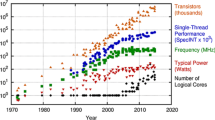Abstract
In this contribution we present a novel general model for adaptive processors. We describe its basic principle of operation and introduce several formal characterizations. The adaptive operations that are possible with this model are thoroughly discussed. The model allows runtime variations of the type and number of functional units as well as variations of the communication structure. We introduce simple heuristics to achieve adaptivity of the architecture. Experimental results show that a processor implementing this model can adapt its architecture to the requirements of diverse applications.
Similar content being viewed by others
References
ajile Systems. aj–100 Datasheet, 2000. http://www.ajile.com/
F. Campi, R. Canegallo, and R. Guerrieri. IP-reusable 32-bit VLIW Risc core. In European Solid State Circuits Conference (ESSCIRC), Sept. 2001, pp. 456–459.
Y. Chou, P. Pillai, H. Schmit, and H. P. Shen. Piperench implementation of the instruction path coprocessor. In Proceedings of the 33th Annual International Symposium on Microarchitecture, pp. 147–158, Monterey, Dec. 2000.
C. Ebeling, D. C. Cronquist, and P. Franklin. Rapid—Reconfigurable pipelined datapath. In R. W. Hartenstein and M. Glesner, eds., Field-Programmable Logic, Smart Applications, New Paradigms and Compilers, pp. 126–135, Berlin, Springer Verlag, 1996.
S. Gatzka, C. Hochberger, and H. Kopp. Deployment of middleware in resource constrained embedded systems. In Tagungsband der GI/OCG-Jahrestagung ‘Informatik 2001’, pp. 223–231, Wien (Österreich), September 2001. Österreichische Computer Gesellschaft.
Y. Ha, R. Hipik, S. Vernalde, V. Diederik, M. Engels, R. Lauwereins, and H. De Man. Adding hardware support to the HotSpot virtual machine for domain specific applications. In M. Glesner, P. Zipf, and R. Michel, eds., Field-Programmable Logic and Applications. Reconfigurable Computing Is Going Mainstream (LNCS 2438), pp. 1135–1138, Berlin, Heidelberg, Springer, 2002.
R. Hartenstein, M. Herz, T. Hoffmann, and U. Nageldinger. Using the KressArray for reconfigurable computing. In J. Schewel, ed., Configurable Computing: Technology and Applications, Proc. SPIE 3526, pp. 150–161, Bellingham, WA, 1998. SPIE—The International Society for Optical Engineering.
K. V. Palem, S. Talla, and P. W. Devaney. Adaptive explicitly parallel instruction computing. In J. Morris, ed., Proceedings of the 4th Australasian Computer Architecture Conference, Singapore, Springer Verlag, 1999.
SIA—Semiconductor Industry Association. The international technology roadmap for semiconductors. http://www.itrs.net/, 2001
Author information
Authors and Affiliations
Corresponding author
Rights and permissions
About this article
Cite this article
Gatzka, S., Hochberger, C. The AMIDAR Class of Reconfigurable Processors. J Supercomput 32, 163–181 (2005). https://doi.org/10.1007/s11227-005-0290-3
Issue Date:
DOI: https://doi.org/10.1007/s11227-005-0290-3




